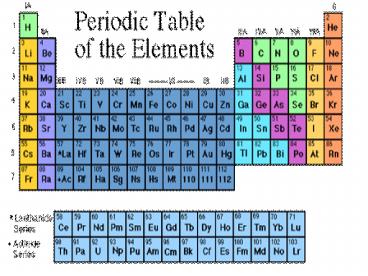Using the Periodic Table - PowerPoint PPT Presentation
Title:
Using the Periodic Table
Description:
Chemical Symbols in the Periodic Table How is the Periodic Table Arranged? Alphabetically from A to Z By atomic mass, from small to large By number of protons ... – PowerPoint PPT presentation
Number of Views:83
Avg rating:3.0/5.0
Title: Using the Periodic Table
1
(No Transcript)
2
Chemical Symbols in the Periodic Table
3
How is the Periodic Table Arranged?
- Alphabetically from A to Z
- By atomic mass, from small to large
- By number of protons, starting with 1
- Randomly
- In the order the elements were discovered
4
Periodic table is arranged by number of protons!
- This is also by Atomic Number
- By coincidence, the elements are generally in
order of increasing atomic mass, but not
always..
5
For example.
- Cobalt has 27 protons, mass 58.9 amu
- Next after Co comes Nickel
- Nickel has 28 protons , but mass 58.7 amu (less
mass than cobalt)
6
Periods
- Periods are the horizontal rows. There are 7
periods
1
2
3
4
5
6
7
(6)
(7)
7
Groups or Families
- Groups (also called families) are the vertical
columns. There are 18 groups.
1
18
8
Most elements are metals
9
Non-metals live in upper right corner (except
Hydrogen)
10
6 Metalloids live near the red stairB, Si, Ge,
As, Sb, Te
X
11
Group 1 metals are called alkali metals
12
Group 2 metals are called alkaline earth metals
13
Transition Metals are in groups 3 through 12They
tend to form colorful ions and compounds
14
Halogens are in group 17 Noble
gases in group 18
15
7 elements are DIATOMIC
16
Allotropes
- Elements that can exist in different forms in the
same phase are allotropes - O2 (oxygen gas) and O3 (ozone) are allotropes
- Allotropes have different chemical and physical
properties
17
Valence Electrons
- Definition all the electrons in an atoms
- HIGHEST ENERGY LEVEL
18
Valence Electrons
- Remember There are seven energy levels
- Energy Level 1 can hold two e- in S orbital
- Energy Level 2 can hold two e- in S, 6 in P
- Energy Level 3 S, P, D
- Energy Level 4-7 S, P, D, F
19
However.
- Since according to the aufbau principle d and f
orbitals fill after the S and P orbitals in the
next highest energy level, - Valence electrons are always in S or P orbitals
- (2 in S) (6 in P) 8 (max) Valence e-
20
How to determine which e- are valence e-
- Step 1 Write out the electron configuration for
the atom - 11Na 1S2 2S2 2P6 3S1
- Step 2 Count how many e- in the highest energy
level - Energy level 3 highest, so there is 1 valence e-
Level 3 is highest
21
The good news
- It is easy to determine valence e- simply by
looking at the periodic table - Group 1 has 1 valence e-
- Group 2 has 2
- Group 13 has 3
- Group 14 has 4
- Group 15 has 5.. Group 18 has 8
22
What about the transition metals?
- For now, assume that they have 2.
- But sometimes they can also have 1, or 3 or more
23
Write out the e- configuration for the following
elements, then check and see what Group they are
in
- 12Mg
- 8O
- 17Cl
- 18Kr
- 26Fe
- 19K

